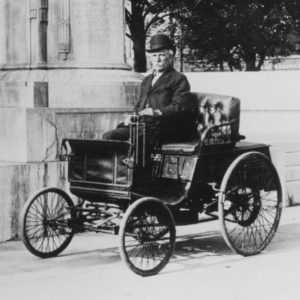
Photo info ...
(Oct. 5, 1852-Aug. 19, 1918). Charles Black, a carriage builder in Indianapolis, asserted that he built the first gasoline-powered automobile in the United States, but the evidence is frustratingly inconclusive. Born near Richmond, Indiana, the C. H. Black Manufacturing Company was the city’s foremost carriage maker by the early 1890s.

A 1913 newspaper story credited Black with building America’s earliest automobile and driving it on the city streets in the spring of 1891. His application to patent his “motor wagon” was rejected because another inventor filed two weeks before him. Black was offered patents on his designs for a differential and a floating axle but angrily declined. The patent records have not survived, but this story ignores the notorious Selden patent, filed in 1879 and issued in 1895. Black said in 1913 that every part of his first car was built in his shop or to his special order, but apart from the wheels and body, it bears a close resemblance to German-built Benz models of 1891 and 1893. The first contemporary report is a brief article in The Horseless Age for February 1897, which announced his intention “to enter into the manufacture of motor vehicles propelled by a rotary gasolene [sic] motor.”
Until his final years, Black drove a one-cylinder vehicle of his own making, donated by his daughter to . He attempted to manufacture automobiles in quantity and issued a catalog about 1897, which showed five distinct vehicles, but the illustrations appear to have been copied from Benz. Black was unsuccessful in raising money to open an automobile factory in Indianapolis and apparently made no effort to continue in the business after 1901.
FURTHER READING
- The American Chauffeur—An Automobile Digest. “One of the First Automobiles.” 1916. https://books.google.com/books?id=whRaAAAAYAAJ&dq=%22One%20of%20the%20first%20self%20propelled%20motor%20cars.%22&pg=PA275#v=onepage&q=%22One%20of%20the%20first%20self%20propelled%20motor%20cars.%22&f=false.
CITE THIS ENTRY
APA:
Furlong, P. J. (2021). Charles H. Black. Encyclopedia of Indianapolis. Retrieved Jan 7, 2026, from https://indyencyclopedia.org/charles-h-black/.
MLA:
Furlong, Patrick J. “Charles H. Black.” Encyclopedia of Indianapolis, 2021, https://indyencyclopedia.org/charles-h-black/. Accessed 7 Jan 2026.
Chicago:
Furlong, Patrick J. “Charles H. Black.” Encyclopedia of Indianapolis, 2021. Accessed Jan 7, 2026. https://indyencyclopedia.org/charles-h-black/.

Help improve this entry
Contribute information, offer corrections, suggest images.
You can also recommend new entries related to this topic.